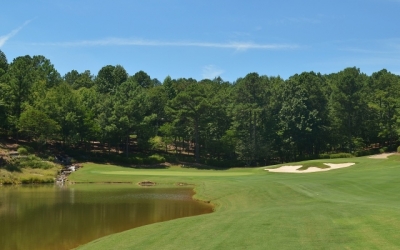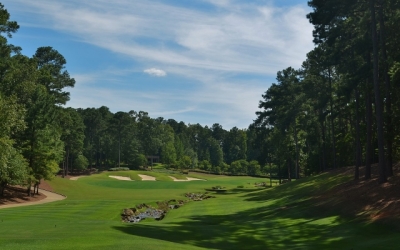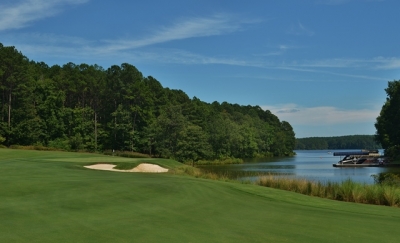By Jeffrey A. Rendall, Photos by Matthew Rendall
GREENSBORO, GA – When a medical student is ready to embark on a career as a physician, he or she must first take the Hippocratic oath, which originated in ancient Greece and roughly translated today means “First, do no harm.”
As far as I know there’s no such equivalent promise for golf architects when tasked with designing and building a new golf course on a pristine and beautiful piece of land, but when it comes to the property Rees Jones inherited on the unsullied shores of Lake Oconee to design a golf layout, he must have felt the urge to swear such a vow.
 |
| Near the green of the beautiful par three 15th hole you get a good sense of the laidback atmosphere that is The Oconee. |
The Oconee Course at Reynolds Lake Oconee opened in 2002, joining the resort/upscale community’s other high-class golf offerings and has been pleasing members, guests and visitors ever since. Best of all, by the looks of the finished golf holes Jones “did no harm” to the remarkable environment -- which is a very good thing indeed.
As you might suppose, Jones was pleased with what he saw when he first glimpsed the setting. “The site was very impressive and we were very excited by the natural diversity of the land. The topography featured significant elevation changes and a variety of valleys and ridges that we incorporated throughout the routing.
“The existing vegetation helped frame the holes and provided an immediate ‘mature’ look and feel. Of course, the unique site attribute was the lake itself. We worked hard to incorporate the lake, both visually and physically, on as many holes as possible.
 |
| Rees Jones gets you started on The Oconee with the 559-yard par five 1st hole, which features an attractive waterfall near the green. |
"I think the combination of all of those elements result in the memorable experience the members and guests enjoy when playing the course.”
By my count Lake Oconee is visible on six holes and comes prominently into play on four, including the spectacular finishing links on both nines. From the back three sets of tees on the par four 18th hole, for example, it’s about a 200-yard carry over the lake to reach the fairway – as much water view as you’ll get anywhere east of Cypress Point or some places in Hawaii.
The “inland” holes run through a natural oasis of hardwoods and pines around dips and swales, across mounds and over ponds and streams. Most courses claim that no two holes are alike but at The Oconee, it’s the truth. The Oconee is not quite as undulated and its elevation changes aren’t as dramatic as its sister course The National (designed by Tom Fazio), but that hardly means it’s flat.
 |
| Looking back from behind the tough par four 16th hole, which richly deserves its #2 handicap designation. |
Topographical diversity is the name of the game on the non-lakeside holes as Jones employed the distinctions of the land to create variety and continuing interest.
By the sound of it the course helped design itself. “The site lent itself to the creation of a great golf course, so we didn’t have to move excessive amounts of fill material, or otherwise undertake any extreme construction efforts to achieve our goals.
“The bridge work was time consuming and not inexpensive, but the results were clearly worth the efforts.
 |
| Strategy is the name on the relatively short par five 7th hole. The second shot is uphill and there are several large bunkers to avoid. |
“In addition, we created a waterfall behind #1 green and a creek feature on Hole #12. The creek has proven to be a unique strategic feature, as well as a stunning visual amenity that players consistently reference when talking about the course. We were fortunate that Mercer Reynolds shared our quality expectations and was so committed to assuring the Oconee Course would be such a special golf course.”
As you’d guess Mercer Reynolds is the resort’s namesake and visionary behind the community’s excellent reputation as an unparalleled place to live, play golf and partake in a whole host of outdoor activities. Anyone who visits clearly recognizes the developer’s eye for quality and uniqueness.
Jones said Reynolds and his team did a wonderful job throughout the planning, approvals and construction process to assure the designer’s vision became reality. Working next to the lake required the typical installation of erosion control and water quality management measures – and there were some wetlands throughout the site – but all in all it was a fairly standard project from a construction standpoint.
 |
| A peaceful trickling stream follows the dogleg right on the par four 12th hole. |
It’s an ecological beauty, too. Wes Forester, Reynolds’ Director of Golf, described The Oconee thusly: “Water features and various types of plant and wildlife add to its beauty. Holes are lined with countless pines and dogwoods as well as oak, magnolia and cherry trees. Ornamentals include the yellow-blooming St. John’s Wort plant, as well as the mule grass that turns purple in the fall. Visible wildlife can include eagles, turkey foxes and deer as well as various species of ducks in the ponds.”
We played in early August so most of the flowering plants were green and lush by that time. We also didn’t see any wildlife on our trip around but it’s not hard to imagine that fauna is plentiful during most months of the year.
Playing The Oconee is a sheer joy. Jones excels at designing supremely playable and enjoyable golf courses devoid of blind shots and tricks. A golf pro at one of his courses once told me, “If you're standing on the first tee, and you can't see precisely the shot you'll need to hit, then you're not on a Rees Jones designed golf course.”
 |
| The lake draws your glance on The Oconee's scenic par four 9th hole, but if you lose it right you will need to reload. |
The course’s five sets of tees – appropriately named one, two, three, four and five (as they are on all of Reynolds’ courses) – step up the challenge considerably. My 10 year-old son played The Oconee from the number five (forward set, 5,198 yards) tees and was able to navigate around easily without having to take on enormous carries or impossible angles.
For those seeking a greater challenge there’s plenty of length from the back set (#1, 7,029 yards, slope of 137). The “in between” tees measure 6,732, 6,294 and 5,718-yards respectively.
Jones says it’s always his goal to create courses friendly to resort players but also challenging enough to host competitive events. “We’ve been very successful designing courses that are playable and enjoyable for all golfers, while also providing the challenge required to test the game’s elite players.
 |
| The tee shot is downhill and the approach shot uphill at the creatively conceived par four 11th hole. |
“That’s really been the cornerstone of my philosophy since I started designing courses. We also wanted to assure the course itself was visually exciting and memorable. I think we achieved that by balancing the presence of water, sand, turf, trees and surrounding landscape plantings.”
The views from most tee boxes are quite friendly with wide and well-defined fairways bordered by manageable rough and attractive bunkering. The Oconee’s green complexes are surrounded by cut-to-fairway-height chipping areas encouraging imagination and creative shot-making instead of simply requiring you to hack it out and hope for the best. On a good number of the holes the fairways are sloped from one side to the other necessitating shot-shaping to place your ball in the optimum spot.
I think it’s called strategy, which Jones says is extremely important when attacking a golf course. “I learned a lot about the game from my dad (Robert Trent Jones). “It’s funny — a while back I did a video about how to play a course’s design, and how it’s important to not just get instruction on how to hit the ball, but rather to learn about how to read a golf course and play within your limitations. The strategy of the game is so important, and I think that’s what we do in our designs — we really work very hard on the strategy to give people alternate shot approaches. And playing the angles, making sure they benefit from playing the proper side of the fairway.”
 |
| The 171-yard downhill par three 5th hole is the first of four spectacular one-shot-ers on The Oconee. Assess the wind and let fly. |
As is true on all of Reynolds’ courses the woods are navigable should you find yourself on the perimeters. Don’t count on a good line to the flag if you’re communing with the trees, however, but you should at least be able to find your golf ball and get it back to the fairway in most cases.
The layout is certainly manageable for the first-time visitor but requires multiple replays to score well. Jones thinks there’s only one way to properly appreciate a course on the initial venture. “If you don’t have a caddy, I think you’re just learning your first time out.
“When you go over to the British Isles, you have caddies. You couldn’t play those golf courses without caddies. Yardage books give you distances and hazard placements, but caddies help you play the wind. Caddies are coming back now at a lot of clubs, so it’s not like they’re a dying breed. So I think you can play a golf course with a caddy and learn much more about it from those who took a lot of people around it before you.”
 |
| Huge bunkers give the impression that the green is tiny at the par three 13th hole - it isn't. |
There is a forecaddie and caddy program at Reynolds and all of the courses offer a friendly tip sheet as well as a detailed yardage book. The day we played The Oconee was fairly warm without a whole lot of wind, so between the tip sheet and a little intuition the course was navigable on our inaugural try.
As one might expect the par fives offer the best birdie opportunities on The Oconee but just like with other Rees Jones courses it’s the par threes that you’ll remember most from the experience.
“The defining feature of the Oconee is its set of magnificent par 3s, featuring elevated tee shots and numerous water hazards that are both eye-catching and penal,” Forester said.
 |
| Plenty of bailout room to the right of the par three 8th hole, but doing so will leave a tough up-and-down. |
The 192-yard, par three fifteenth is the true embodiment of “eye-catching and penal” on The Oconee. From the #1 tees it’s a full carry over water and sand to reach the green though there is ample bailout room to the right side of the hole if you choose the safe route. Lake Oconee dominates the views on the left, with numerous residents’ docks and boats in sight. It’s a heck of a setting!
Forester says The Oconee’s highlight holes are the three closing links.
“The par four sixteenth hole ranks as one of the course’s toughest par 4s (#2 handicap), due to its length (422-yards and uphill) and a creek that runs up the left side to a picturesque waterfall near the front of the green. A bailout on the left allows run-up shots.
 |
| Close to the green on the par five 17th hole you can't help but appreciate the work it took to construct The Oconee. |
“The par five seventeenth hole features a downhill second shot which makes reaching this green a possibility, but bunkers on both sides of the sloping fairway must be avoided. The lake becomes a major distraction in hitting an approach that can be rolled up to the green.
“The closing par four eighteenth is one of the toughest and most beautiful holes on the course. No. 18 requires a tee shot that carries the lake and avoids a fairway bunker on the left side. The long second shot must be threaded between front greenside bunkers.”
If you’re not properly placed off the tee of the eighteenth it’s more like a short par five for most players. Bogey isn’t a bad score when walking off the green of this one. The lake surrounds the hole – take a moment and absorb the experience.
 |
| The 356-yard 6th hole is the shortest par four on The Oconee but it's no pushover once you reach the sloped green. |
Hard as it is to believe, the golf course isn’t the complete experience at The Oconee. Jones is rather proud of the practice facilities he put together as well. “Another unique feature of this course, which definitely appeals to the resort aspect of the project, is the expansive and diverse practice and learning facility we created. Here, all golfers can practice or learn every aspect of the game in a beautiful setting.”
No doubt. The other end of the practice range is the location of The Kingdom of Golf where you can be fitted by top professionals for all the latest in TaylorMade equipment. It’s just one of many offerings at Reynolds that avid players can take advantage of. I myself was fit by Noel English, the same gentleman who works with Top-10 PGA Tour pro Justin Rose.
I asked Jones what was the one thing that stood out about The Oconee project compared to the hundreds of worldwide courses he’s worked on throughout his life. “I think it’s probably more than just one thing,” Jones replied thoughtfully.
 |
| Coming home on the challenging par four 18th hole you've got one final difficult tee shot to execute. |
“Clearly, the manner and frequency in which we were able to incorporate the lake throughout the golf course, including views of the lake, are major elements that make the Oconee Course so unique. In addition, I think the way we were able to route the holes and capitalize on the significant opportunities and diversity provided by the existing topography, combined with the mature vegetation, resulted in a variety of holes that look and feel very natural.”
I couldn’t have said it better myself. Put Reynolds and The Oconee course high up on your golf bucket list – you won’t be disappointed.
Details:
1031 Cottage Road
Greensboro, GA 30642
Phone: (706) 467-1200
Web: https://www.reynoldslakeoconee.com/golf/courses/oconee
Course Designer: Rees Jones
Director of Golf: Wes Forester
Course Superintendent: Brad DiMascio
COURSE STATISTICS:
Greens Fees:
$280 for Peak (April 1-July 4 and September 1-November 13)
Check the website for current rates and package deals.
Note: Walking is an option and it is encouraged.
| Related Links | Comments on this article? | |
|
Maryland National Golf Club Hollow Creek Golf Club Rocky Gap Resort PB Dye Golf Club in Ijamsville Whiskey Creek Golf Club |
E-mail Jeff Rendall, Editor: jrendall@golftheunitedstates.com |











